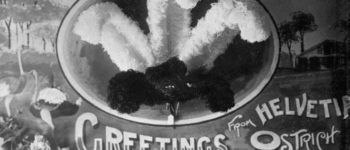1884: Eulogy for Helvetia
May 12, 2019
By AHNZ
 Excuse me! This is not simply “Hart Road, Pukekohe; DECEASED ESTATE – RENOVATOR’S DREAM OPPORTUNITY.” This was Helvetia, once a living and cultured Swiss New Zealand community. Still on the map as such.
Excuse me! This is not simply “Hart Road, Pukekohe; DECEASED ESTATE – RENOVATOR’S DREAM OPPORTUNITY.” This was Helvetia, once a living and cultured Swiss New Zealand community. Still on the map as such.
Sadly the owners have now passed and the property needs someone to restore it to its former glory, reaping excellent rewards and undoubted satisfaction in the process.- Real estate listing
Helvetia, est 25 March, 1884, took the ancient name of Switzerland, equivalent of our ‘Britainia’ or ‘Zealandia’. 4000 acres “of virgin land” had been purchased, right along the railway line to Auckland. Here the yodelling Swiss farmed their dairy, poultry, and grapes.
Mr Ernest Engster, the commissioner of Swiss Court at the Adelaide Exhibition..has purchased, on behalf of a syndicate of Swiss gentlemen, a large block of nearly 4000 acres of virgin land in Pukekohe…have it settled by industrious farmers, chiefly Swiss. He believed there is better scope for the hard-working, thrifty tillers of the soil in the colonies than in the old country. The new settlement is to be called Helvetia.- A SWISS SETTLEMENT IN NEW ZEALAND, Temuka Leader, 11/11/1882; Papers Past
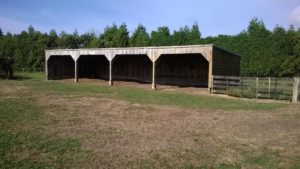
The four-bay shed photographed is the oldest structure on the property. Probably itself dates from 1884. Then came the railhead. This ole house once knew his children, this ole house once knew his wife, this ole house was home and comfort as they fought the storms of life…
Helvetia is already making a good show, as seen from the railway line, numerous shelter, forest, and fruit trees having been planted, end other improvements made. We wish the settlement every prosperity.- The Settlement of Helvetia; New Zealand Herald, 26/8/1884; Papers Past
Helvetia Ostrich Farm Company
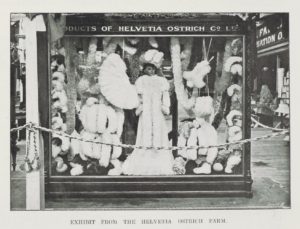 Established c.1902, the Helvetia Ostrich Farm ran a great trade while it lasted. These birds offer huge eggs, great meat, strong pelts and fast growth if they survive their vulnerable fledgling phase. In a case of history repeating, the 1990s also saw a global mania for ostrich farming that has come and gone from New Zealand. The Helvetia concern had the advantage of huge customer demand for feathers at a time before the technology existed to create them synthetically. They also capitalised on tourism, attracting visitors for rallies and picnics to view the strange beasts. At one point they even drummed up business by having the Governor Baron Plunket and his wife drop by. The tourism would have helped when the interest in feathers waned…
Established c.1902, the Helvetia Ostrich Farm ran a great trade while it lasted. These birds offer huge eggs, great meat, strong pelts and fast growth if they survive their vulnerable fledgling phase. In a case of history repeating, the 1990s also saw a global mania for ostrich farming that has come and gone from New Zealand. The Helvetia concern had the advantage of huge customer demand for feathers at a time before the technology existed to create them synthetically. They also capitalised on tourism, attracting visitors for rallies and picnics to view the strange beasts. At one point they even drummed up business by having the Governor Baron Plunket and his wife drop by. The tourism would have helped when the interest in feathers waned…
We learn that an important step has just been made in the development of the ostrich feather industry in Auckland..Mr. John Schlaepfer, of “Helvetia,” Pukekohe,…and the prospects of the industry may be gauged by the fact that the present supply of feathers is equal to only about one-third of the Auckland demand, to say nothing of the Southern markets.- Local and General News; NZ Herald, 4/10/1902; Papers Past
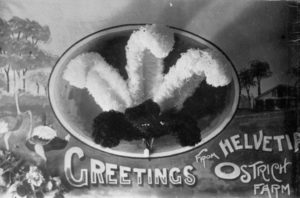 Why 1902? When English nations invade/fight overseas they bring back the spoils and the values. From India, tea. From South America, tomatoes and the potato. Having just fought the South African War¹ it was time for our victorious culture to revel in the likes of the ostrich² [for more on this phenomenon see previous post: Conquered Pacific Theatre Converted into Americana.] Our wealthy turn-of-the-century ancestors were crazy about these adornments but only until c.1913 when the culture changed back to Honour Culture for WW1.
Why 1902? When English nations invade/fight overseas they bring back the spoils and the values. From India, tea. From South America, tomatoes and the potato. Having just fought the South African War¹ it was time for our victorious culture to revel in the likes of the ostrich² [for more on this phenomenon see previous post: Conquered Pacific Theatre Converted into Americana.] Our wealthy turn-of-the-century ancestors were crazy about these adornments but only until c.1913 when the culture changed back to Honour Culture for WW1.
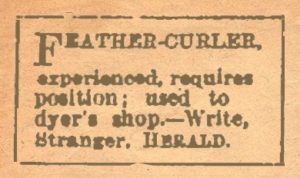 After the war, in the early 1920s, as per Laver’s Law, the feather rose again and Helvetia feather once more became a lucrative trade for a bit.
After the war, in the early 1920s, as per Laver’s Law, the feather rose again and Helvetia feather once more became a lucrative trade for a bit.
“In the years 1885 and 1913 feathers went out of fashion. James Laver’s law of the trend lifecycle says that items fall in and out of favour and can be appreciated again after a certain period of time has passed.”- Ostrich feather trade; City of London
Demise
 From father to son the blood runs thin. The Harts of Hart Road must have died recently (several recent obituaries) leaving nobody to take up their territorial soil; Nobody who would not rather the money. This deceased estate sale represents the finish of a dynasty. Further along, the Hart Rd joins Schlaepfer Road, named for another old Swiss neighbour.
From father to son the blood runs thin. The Harts of Hart Road must have died recently (several recent obituaries) leaving nobody to take up their territorial soil; Nobody who would not rather the money. This deceased estate sale represents the finish of a dynasty. Further along, the Hart Rd joins Schlaepfer Road, named for another old Swiss neighbour.
One of the Helvetia families associated with Patumahoe were the Schlaepfer’s. Pictured [above] is the family in their first car, a 1925 Austin Seven in the late 1920s.- Patumahoe History and Memories; Facebook 2016
The Schlaepher dynasty came to a horrible bloody jolt with the Schlaepfer farm murders of 1992; Grandfather Schlaepfer murdered his 3 sons, grandson, his own wife, and himself. I bet that didn’t go down well with the Harts or the Swiss Society Annual Newsletter.
Anyhow, their locus appears now to be at Kaukapakapa or perhaps Penrose where yesterday (4 May 2019) the annual Swiss Market was held.
Little Holocausts
New Zealand history is full of ‘little holocausts’, most of them will always go unrecorded. Especially the little rural subcultures will be forgotten forever because they leave no monuments or art or literature like the Greeks or Romans. Just shelter belts, wells, clear land, and relic out-buildings like Helvetia’s.
Mr Real Estate Agent wont tell. Doesn’t know. The Swiss know, if any remain. Or do they even care? I can tell the story (deduce and guess at it) as a distant chronicler and as far as we can expect this has been the only eulogy for Helvetia.
Feeling sympathetically bereaved.
—
1 Aka Boer War
2 Update 2023: This wasn’t the first wave of interest. Turns out Eastern Auckland, Whitford, had a farm too. The Scramble for Africa evidently captured our Anglo-Zelandian imaginations in the 1880s and so we wanted access to the exotic aesthetics
image ref. Homestead; Scott McElhinney & Associates – The Luxury Lifestyle Team; Barfoot.co.nz
image ref. Old shed; AHNZ archives (2017)
image ref. Helvetia feathers on show in 1906; Auckland Libraries Heritage Collections
image ref. Schlaepfer’s car, 1925; Patumahoe History and Memories
image ref. Greeting card from Helvetia Ostrich Farm; Estate of Thomas Jackson Grant; Alexander Turnbull Library
UPDATE: Image ref. Job wanted by feather curler; History Always Repeats: Remembering New Zealand; New Zealand Herald, May 1911
 Like Comment Share
Like Comment Share

